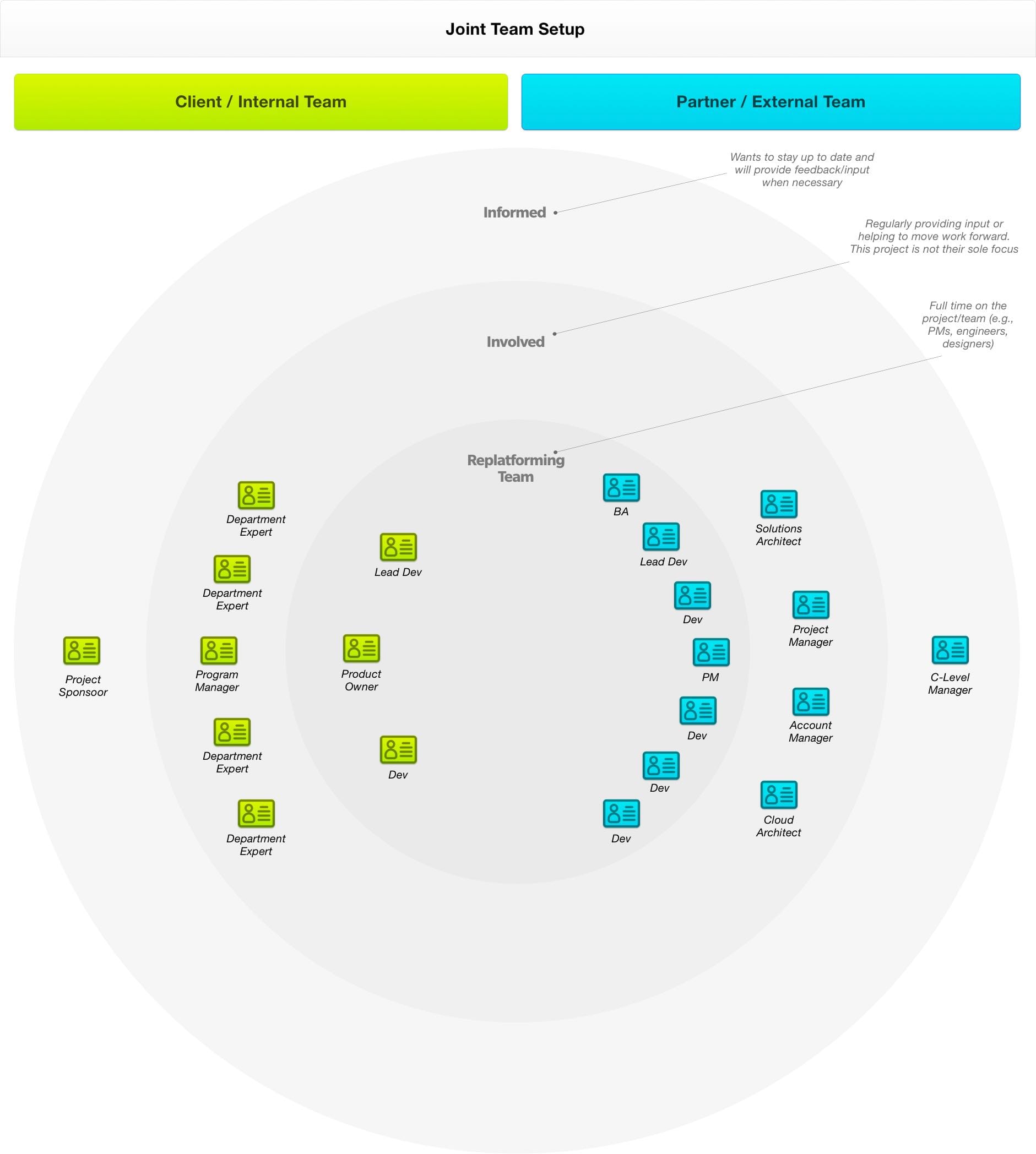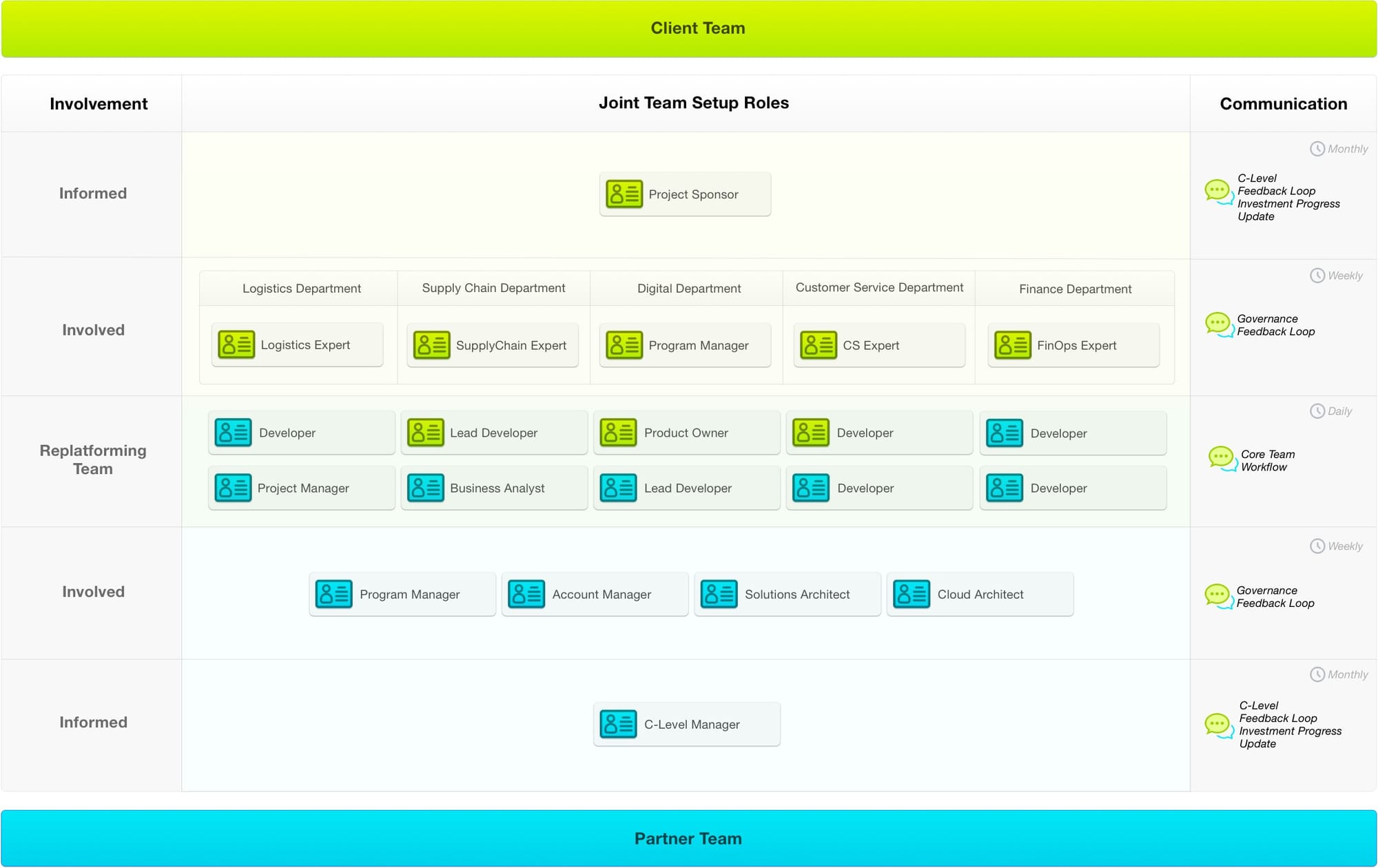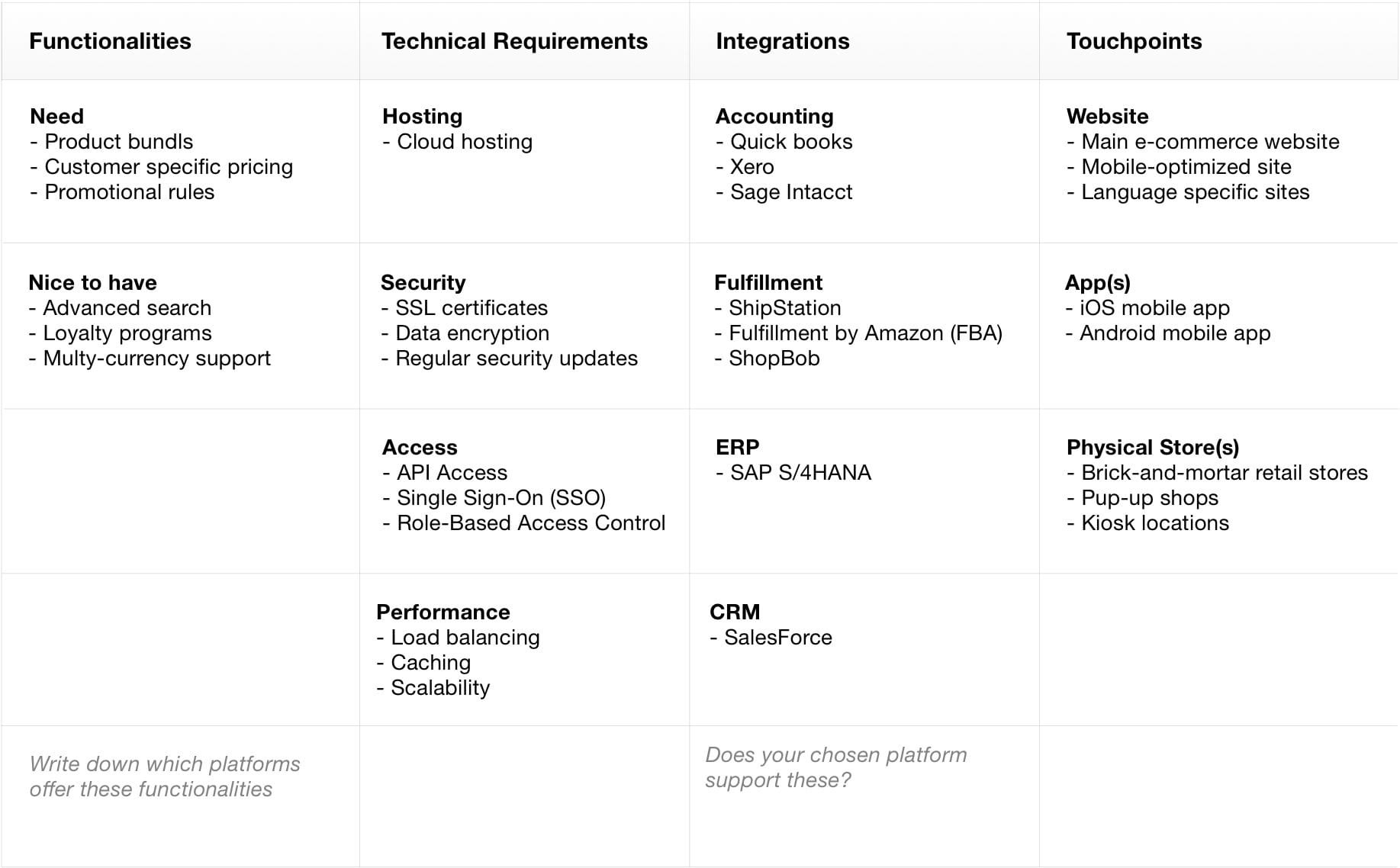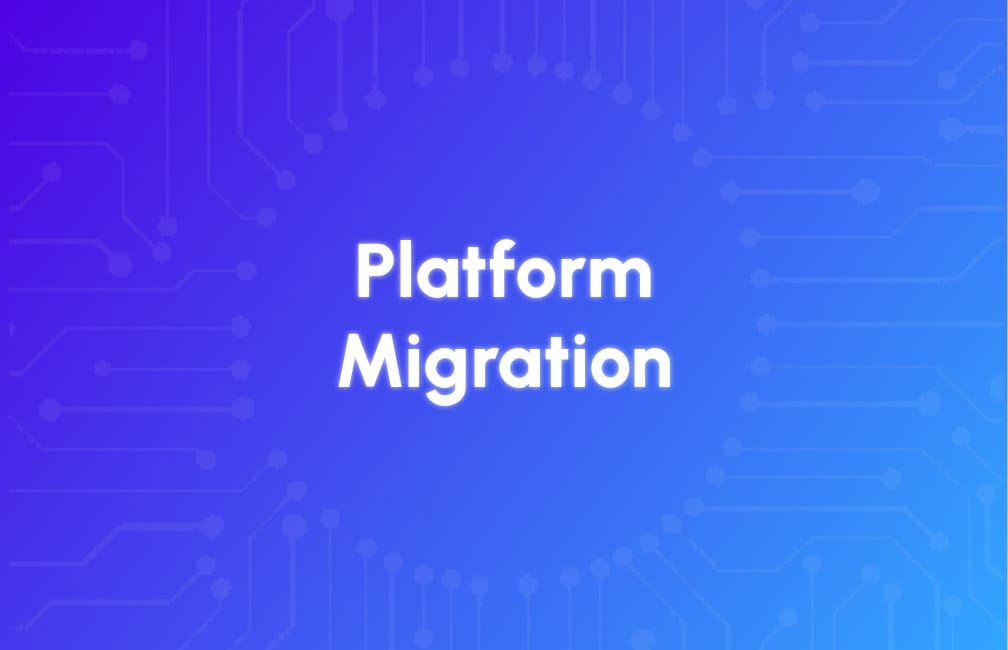The e-commerce market is evolving rapidly, with new solutions and fresh competitors constantly popping up. Staying ahead of the curve is crucial, and that's where a robust re-platforming strategy comes in.
Here we explore how you can develop a technical platform that meets your current needs and adapts seamlessly to changes. The practice shows that a lot of important insights go beyond just IT and tech into organisational structure and psychology. So here’s a sneak peek at what we’ll explore:
- Why is a replatforming strategy important in 2024, and what should e-commerce professionals and business owners consider when developing one? You’ll go through some key considerations to keep in mind, from business goals to tech requirements.
- What would your team, approach, and tools look like for a successful replatforming? Who should be on your team? Which methodologies and tools should you use? What constitutes a bad practice?
- What does a platform that allows continuous updates and fine-tuning look like in 2024? Let’s paint a picture of the picture-perfect e-commerce platform, the dream one, which is flexible, scalable, secure, and ready for whatever the future holds all at the same time.
Ready to future-proof your e-commerce business? Let’s dive in!
Why not to migrate?
First off, these are some of the wrong reasons to engage into a migration project:
- "Our competitor started a migration project, we should too."
- "We keep hearing about this new technology/approach everybody's talking about, why not to try it."
- "We just got contacted by a technology vendor that promises to solve all our business problems with their new platform."
Why migrate?
Replatforming isn’t an end goal, nor should it be done for its own sake just because your competitor is doing it. Rather, it is a response to the evolving needs of various stakeholders. A solid strategy will ensure your platform can scale, integrate new technologies, and deliver top-notch user experience.
Customers now expect much better service, a wider product range, and new ways to interact with products online. Internally, your organization might need to respond faster to market changes, personalize products using customer data, or expand into new markets because investors have big plans and you need to implement them fast. Additionally, you always need to cut the overall costs of running your online platform and replatforming might well help with it.
The first step in your journey would be to access your current setup and clearly define your specific e-commerce goals. Here are some questions you may go through with your team:
- What are the current limitations of our existing platform?
- What specific functionalities do we need to improve our customer experience?
- How can we ensure seamless integration with our current systems and future expansions?
- What are the projected costs and potential savings of replatforming?
Such work might seem trivial at first glance, but it will guide the project, spare you the headache, and additional costs, and help assess whether you’ve achieved the intended results.
Legacy platforms tend to have one or more of these problems:
- Hard or inconvenient to manage
- Difficulties with scaling
- Not enough flexibility
- Lack of innovation and adaption
- High development and maintenance costs
Key Business Considerations
Delivering digital customer experiences
To boost customer satisfacation and maintain long-term revenue streams, it's crucial to enhance digital capabilities and invest in omnichannel strategies.
- Are your customers satisfied with their current shopping experiences?
- What improvements are needed to increase customer satisfaction rates?
- Can you provide accurate, real-time information on pricing, products, and availability?
Improving Operations
Isolated data systems and repetitive manual tasks diminish your business performance, speed, and employee morale. Optimizing operations is essential for maintaining competitiveness.
- What is the current frequency of errors and data inconsistencies you encounter?
- How straightforward is it to add new features or integrate third-party systems like an ERP?
- How many manual, time-consuming tasks, such as phone or fax orders, could be automated with technology?
Optimize Costs
If maintaining your commerce platform requires substantial resources, reducing infrastructure, maintenance, and upgrade costs becomes essential.
- How much effort does your tech team dedicate to maintenance and resolving bugs?
- How much technical debt has built up within your commerce ecosystem?
- Are your licensing and hosting costs high or increasing?
Accelerate Return on Investment
It's essential to safeguard current revenue streams and create new avenues for increasing profits by keeping pace with market trends and customer expectations.
- How quickly can you modify and expand functions to seize new opportunities?
- How effectively does the system scale to manage a large number of SKUs and high order volumes?
People are Key
The team you chose for the process will be defining for its success or failure.
Define clear roles and responsibilities before you start replatforming. It never works on the go. I can’t stress this enough. It is a bad practice, even though it’s the most common one. Confusion and miscommunication can become rampant and important tasks might be overlooked if no one is explicitly assigned to them.
You also most definitely don’t want to deal with duplication of efforts, conflict, tension, and overall lower morale. Plus, with reduced accountability, it will be quite challenging to hold anyone accountable for any mistakes or missed deadlines.
Start by forming a diverse team, identifying everyone’s roles, and assigning clear ownership to managers. Classify internal and external stakeholders based on their roles, understand their needs, and keep them regularly informed about your progress, including any successes or setbacks along the way. This approach will save you from a lot of headaches and ensure a smoother replatforming process.
Here's a brief visual stakeholder chart you can draw and fill in yourself. It should involve all your stakeholders, the team that will be responsible for replatforming, and people in your company who are outside of the core team but might be important.
Composition and Responsibilities
A successful replatforming process hinges on the team you put together. While the specifics can vary from one organization to another, business ownership must stay with the people within the company. Although rare, I’ve seen senior management play a vital role in monitoring the replatforming investment through regular feedback. Product owners or project managers in the replatforming team need the authority to make interim decisions because they uniquely understand both the business and technical aspects of the transition. Without this authority, some stakeholders' interests may be at risk. Having a core team with members from sales, development, digital marketing, and architecture is essential for success.
Implementation Approach
The more integral IT, e-commerce, and digital are to your business, the more crucial it is to have the right expertise and continuously develop it. An agile implementation approach, which emphasizes constant feedback and improvement, has works wonders. For most companies bringing in external help is often necessary, sometimes it is the only option. That's where joint team setup becomes essential.
Create an overview of all your stakeholders using any available method that fits your preferences and particular needs.

Establish your feedback cycles as a pre-scheduled recurring meetings with a clear agenda and only relevant participants in them.
Such monolith meetings, once emerged, tend to grow to a surprisingly large scale and become unbearably long at times, especially in already large yet dynamic organisations. Usually this is a good indication of a malfunctioning communication loop between various levels of organisation. Try to avoid this phenomena at all costs. Setup your communication loops beforehand and adjust them as you go. This will help you to save time, budget, and team motivation.
Here's another perspective on a joined team setup from a previous illustration with some corresponding communication loops.

Particularly for large projects with many stakeholders involved, you would also want to create a map of all participants, capturing their expectations. A well-established project setup bridges the communication gap between business and technology functions, yet considers the separation of concerns across various levels of the organization chart, from C-Level to Development.
Another crucial aspect, often overlooked in such mission-critical projects, is the empowerment of the core team with decision-making responsibilities. Roles like Product Owner, whether an internal or external team member, navigate through a network of trade-offs throughout the entire project lifecycle. Empowered POs, together with Project Managers and Tech Leads, should play a major role in team staffing as well as effort and budget allocation decisions on a daily basis.
In a scenario of a joined team setup, a solid transfer of knowledge to the internal (client) team is an important part of the process. Without this transfer, your team might struggle to maintain and adapt to the new platform, leading to increased dependency on external parties and potentially much higher costs. It's best to see knowledge transfer as rather a continuous process taking place frequently, not as a single event during the project release or handover. Make documentation and workshops an integral part of your project scope and your organisation will own and maintain the new platform with ease and confidence.
If IT, e-commerce, and digital aren't at the heart of your business, a project-based implementation as opposed to program-based approach might be better. I've even seen instances where outsourcing the entire process worked well. It's essential to stay in close contact with your internal steering group and keep an eye on e-commerce trends. While agile methods are popular, a conventional or hybrid approach like the Dynamic Systems Development Method (DSDM) can sometimes lead to better results, especially for big bang or channel-specific migrations.
Conceptual Considerations
Project vs Program: mode of the initiative should reflect its scale, expected scope, complexity and other criteria.
Team Composition: Ensure a diverse team with clear roles, including members from sales, development, digital marketing, and architecture.
Senior Management Involvement: Regular feedback and monitoring of investments. Mandate for Interim Decisions: Empower product owners or project managers.
Empowered Core Team: having more decision making power improves team efficiency.
External Expertise & knowledge transfer: For smaller companies, ensure knowledge transfer from external parties.
Project-Based vs. Agile Approach: Choose based on the integral nature of IT, e-commerce, and digital to your business.
Stay Informed: Keep up with e-commerce trends and maintain close communication with internal stakeholders.
By focusing on these aspects, you can navigate the complexities of replatforming much more effectively, ensuring a smoother transition and better alignment with your business goals.
Technical Prep Work
So what makes a robust e-commerce platform tick? Choosing the right architecture is crucial for a successful replatforming process. Although overlooked in many cases, the architecture serves as the blueprint of the whole platform, outlining the various components and systems and how they are connected. Without such a blueprint, the setup soon becomes a mess, much like attempting to assemble a piece of furniture without following the visual instructions provided. You might have all the pieces laid out in front of you readily available, but without a clear plan of how they fit together, you'll likely end up with a wobbly table or a crooked bookshelf. Similarly, in e-commerce, without a well-defined architecture guiding the integration of various components, you risk ending up with disjointed systems, inefficiencies, and a poor user experience.
It also specifies the information flows between these components and where all information is stored. Typically, the architecture includes several functional building blocks or layers, such as touchpoints visited by end users (websites, online stores, chatbots, social media, voice applications, IoT applications), systems for managing information (CMS, PIM, DAM), back-office systems for internal processes (ERP, financial packages, order-management systems), external systems/sources (payment providers, review websites), and integrations between these components.
Choosing the best architecture depends entirely on the organization's needs. While every e-commerce platform includes many functional standard components, the required architecture will vary based on factors like the number of channels, the preferred market approach, and the size of the organization. For instance, a large enterprise with multiple sales channels might need a more complex architecture than a smaller company focusing on a single online store. The key is to align the architecture with your business goals and operational requirements, ensuring it supports both current needs and future growth.
Here are some main types of architecture to consider: Monolithic, Modular Monolithic, Best-of-Breed, and Microservices.
- Monolithic Architecture: Combines most functionalities into one package, ensuring optimal alignment but limited customization. Ideal for small organizations or those with straightforward requirements due to its simplicity and ease of management.
- Modular Monolithic Architecture: structures the application into independent modules or components with well-defined boundaries.
- Best-of-Breed Architecture: Uses interconnected systems to select solutions that best meet specific needs, offering flexibility but potentially time-consuming integration. Suited for medium-sized businesses needing tailored functionalities.
- Microservices Architecture: Involves multiple smaller systems and services linked via APIs, offering high flexibility and easy service updates. Requires significant expertise to design and manage. Best for large organizations with complex needs due to its scalability and adaptability.
Selecting eCommerce Platform
Distinguishing between e-commerce systems is crucial because each system offers unique benefits and challenges that can significantly impact your business operations. Unpopular opinion: choosing the right e-commerce system is not just a technical decision as it seems but a strategic one. In the context of selecting the right architecture, it’s important to understand these differences because the architecture you choose needs to align with the specific functionalities and support structures of your chosen system. You can’t simply pick an architecture in isolation; it has to be compatible with your e-commerce platform to ensure seamless integration, scalability, and optimal performance. Think of it like choosing a house – you wouldn’t design the interior without considering the layout and structure of the building itself.
So, why can’t we just mix and match them? Well, imagine trying to fit a square peg in a round hole – it’s just not going to work without a lot of frustration and potentially costly adjustments!
In IT architecture, it’s crucial to start your selection process with a clear list of needs and requirements. Consider the unique characteristics of the products or services you plan to sell. For example, if you’re dealing with product bundles, customer-specific pricing (especially in B2B), or specific promotional rules, these should guide your decision.
Here are some basic aspects to help outline your needs. By considering these factors, you’ll be well on your way to selecting the right e-commerce platform and saving yourself the headache of dealing with problems going forward.

Order Management
- Capability to process large orders
- Features for reordering and order scheduling
- Bulk pricing options
- Customer-specific pricing and discounts
- Complex order workflows
- Quote generation, negotiation, and management
- Support for individual SKUs
- Scalable pricing support
Business type specific requirements
- Manage complex pricing and discount structures
- Offer customer-specific product catalogs
- Provide multiple payment and shipping options
Omni-channel
- Support for omnichannel strategies
- Integration with ERP and CRM systems for seamless data synchronization
Product Catalogue
- Manage complex product relationships and categorization
- Support multiple product variations and configurations
- Accommodate custom and complex products
Complex approval processes for purchasing
- Custom approval workflows
These are just examples. Write down your functionalities, requirements, needed integrations, and touchpoints specific to your technical and strategic business goals in mind.
Why Marketing Requirements should not be overlooked?
The previous table deals with the tech side of the transformation process, but marketing requirements are just as important. They are often overlooked or underestimated in tech decisions. However, as I mentioned earlier, platform migration is not just a technical move; it’s a strategic one. Ensuring that your chosen platform meets your marketing needs is crucial for maintaining brand
consistency, engaging customers, and driving sales, especially for B2C platforms.
Imagine a situation when a fashion retailer focused heavily on the technical aspects of their platform migration but neglected their marketing needs in the process of platform migration. They chose a platform that lacked robust SEO tools and had limited integration with social media channels. As a result, despite
their flawless technical setup, their online presence suffered, and they struggled to attract and retain customers. Their brand visibility decreased, and they lost out on significant sales opportunities. So disregarding marketing requirements can sabotage all the hard work you put into the technical side of your e-commerce transformation. It's essential to balance both to ensure a successful platform migration. Make the marketing team your best friend and listen to them carefully as they might have an important overview you might be missing.
Here are some key marketing requirements to consider:
- Branding Customization: Does the platform allow for extensive branding customization to align with your brand identity?
- SEO Capabilities: Does the platform offer built-in SEO tools or plugins to optimize search engine rankings?
- Social Media Integration: Can the platform seamlessly integrate with social media channels for marketing and sales?
- Email Marketing Tools: Does it support email marketing campaigns and customer segmentation?
- Content Management: How flexible is the content management system for creating and managing marketing content?
- Analytics and Reporting: Does the platform provide robust analytics and reporting tools to track marketing performance?
- Promotional Tools: Are there tools for running promotions, discounts, and special offers?
- Customer Engagement Features: Does the platform support customer reviews, ratings, and feedback mechanisms?
Preparation Work Step-by-Step
- Determine your business drivers and customer needs
- Gather and prioritize critical customer feedback.
- Define the business drivers for a replatforming project, such as reducing TCO, increasing revenue, and enhancing customer experience.
- Conduct a technology audit based on your business drivers and strategy.
- Evaluate the implementation time frame for the new solution.
- Align business requirements with new platform capabilities
- Review out-of-the-box features and components, like order scheduling, quote management, and payment and shipping options.
- Assess new features and components for future needs and scalability.
- Evaluate frontend/UX capabilities.
- Assess auto-scaling capabilities, reliability, and security.
- Analyze the pricing model from a long-term perspective to get a full TCO picture.
- Ensure support for various levels of access and permissions.
- If needed, select an integration partner.
- Customization, integration, and personalization
- Evaluate support for omnichannel and personalization strategies.
- Review customization options, such as extension points and product configurations.
- Assess personalization options, including order history and product catalogs.
- Evaluate integration capabilities with top suppliers and internal applications like ERP and CRM systems.
- Review pre-built connectors and integration tools.
- Data migration
- Ensure built-in import-export functionality for data migration.
- Check if a phased migration approach (strangler pattern) is possible.
- Choose a migration strategy based on your requirements and team capabilities.
- Training, support, and documentation
- Review training materials and support information.
- Assess business tools.
- Evaluate technical documentation.
Tech Execution
So you’ve done all the hard work. The prep is never an easy step. After making decisions about architecture, platform, team composition, and implementation, and input from teams across the company, the next crucial step is choosing the right migration strategy. And here we come to the fun part – an actual execution considering all the requirements.
While the migration process might seem to be straightforward, it involves several different approaches you might choose to follow. There are three main scenarios to consider, each with its variations.
- The "Big Bang" approach involves building the new platform entirely while the existing one continues to run. In this case, migration happens all at once. This is typically the only option for more monolithic applications and often involves a purchased package or solution. This approach requires meticulous planning and testing to ensure a smooth transition with minimal downtime.
- The "Per Channel" strategy builds the platform for one specific channel at a time, such as mobile, app, or in-store, before rolling it out to other channels. This method allows for more manageable phases and can help identify issues on a smaller scale before a full rollout. I've found this approach particularly effective for businesses with diverse sales channels, as it minimizes risk and disruption.
- The "Strangler Pattern", "Gradual" or "Pacman" method replaces functionalities piece by piece, allowing the new platform to integrate with the old one gradually. This might mean the front-end combines features from both the old and new platforms, or users see the new site during specific parts of their journey, like checkout or self-service options. In my experience, this approach offers the most flexibility and reduces the pressure on IT teams, as changes are implemented incrementally and can be adjusted based on real-time feedback.
Choosing the best migration strategy depends on your organization’s unique needs. Consider how easy it will be to replace the current platform in one go or gradually if it fits your goals or dependencies better and how complex it will be to integrate with other systems like ERP and CRM.
Key Considerations:
- System Compatibility: Ensure the new platform can seamlessly integrate with existing systems like ERP and CRM.
- User Experience: Evaluate how each migration strategy will impact the user experience during the transition period.
- Risk Management: Consider the potential risks associated with each approach, such as downtime, data loss, or user disruption, and plan accordingly.
Key takeaways:
- Big Bang: Ideal for monolithic applications, involves a single, complete migration.
- Per Channel: Implements the new platform one channel at a time, such as mobile or in-store.
- Gradual: Replaces functionalities piece by piece, allowing for a smoother transition.
Each approach has its benefits and challenges, so once again just like in the planning carefully evaluate which strategy aligns best with your business goals and technical requirements.
Bonus Level Recommendations

Here are some additional recommendations that can save you a lot of headaches during a replatforming project:
When replatforming, it's crucial to keep your project focused. Avoid letting it expand with additional tasks just because you think, "We might as well do this too." Remember, trying to make your e-commerce platform completely future-proof is unrealistic. Instead, make smart, practical decisions based on current
needs, knowing that replatforming will likely) happen again, as long as you’re still on the market.
Successful entrepreneurs focus on what makes sense now and adjust as their business evolves. Also, set clear KPIs from the start to measure success and identify areas needing improvement. Finally, don't underestimate the complexity of replatforming. You might discover your existing systems are more intricate than anticipated, and getting everyone in the organization aligned can be a significant task. It’s a bit like trying to change the tires on a moving car—challenging but doable with the right approach.
Quick Recap: Replatforming your eCcommerce Business
Congrats on making it to the end! 🎉 Here’s a recap of all the key points we’ve covered:
Why Replatforming?
- Not Just a Tech Move: It’s a strategic necessity to respond to evolving needs.
- Customer Expectations: Better service, a wider product range, and new interaction methods are a must.
- Cost Efficiency: Reduce overall running costs with a well-thought-out replatforming strategy.
Starting Your Journey
- Assess Current Setup: Identify limitations and needs.
- Key Questions to Consider:
- What are our current platform’s limitations?
- What functionalities will improve customer experience?
- How can we ensure seamless integration with future expansions?
- What are the projected costs and savings?
People Are Key
- Define Roles and Responsibilities: Avoid confusion, duplication of effort, and lower morale.
- Team Composition: Include members from sales, development, digital marketing, and architecture.
- Senior Management Involvement: Regular feedback is crucial.
- Empower Decision Makers: Product owners or project managers must have the authority to make decisions.
Technical Prep Work
- Choosing the Right Architecture.
- Monolithic: Simpler but less customizable; good for small, straightforward needs.
- Modular Monolithic: a more sophisticated and flexible approach to monolith.
- Best-of-Breed: Flexible and tailored; great for medium-sized businesses.
- Microservices: Highly scalable and adaptable; best for large, complex operations.
E-commerce System Selection
- Understand the Options. Open Source: Free but limited support. Enterprise Systems: Feature-rich but risk vendor lock-in.
- Microservices/API-based: Flexible but requires significant customization.
- Custom-made: Perfect for unique or heavily online-dependent businesses.
- Avoid the Square Peg in a Round Hole: Match your system to your architecture for seamless integration.
Marketing Requirements
- Don’t Overlook Marketing: Neglecting marketing needs can sabotage your technical setup.
- Key Marketing Considerations: Branding customization, SEO capabilities, Social media integration, Email marketing tools, Content management, Analytics and reporting, Promotional tools, and Customer engagement features.
Technical Execution Strategies
- Big Bang: All-at-once; good for monolithic applications but requires meticulous planning.
- Per Channel: Implement one channel at a time; minimize risk and disruption.
- Strangler Pattern/Gradual/Pacman: Replace piece by piece; offers flexibility and real-time adjustments.
Bonus Level Recommendations
- Keep It Compact: Avoid project creep with unnecessary additions.
- Focus on Current Needs: Future-proofing is a myth; make decisions based on what makes sense now.
- Measure Success: Set clear KPIs to evaluate performance.
- Don’t Underestimate Complexity: It’s like changing tires on a moving car – tricky but manageable with the right approach.
We'll explore more on the topic of migration with its best practices in the upcoming posts.


